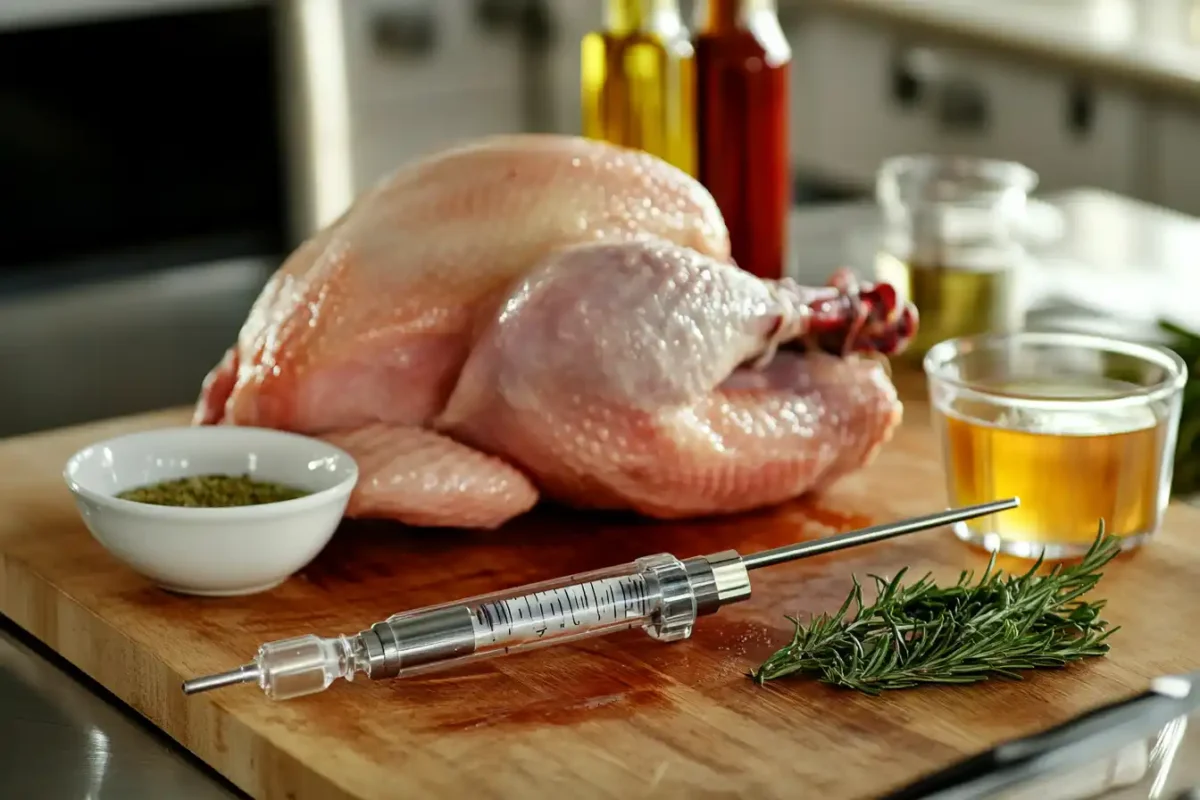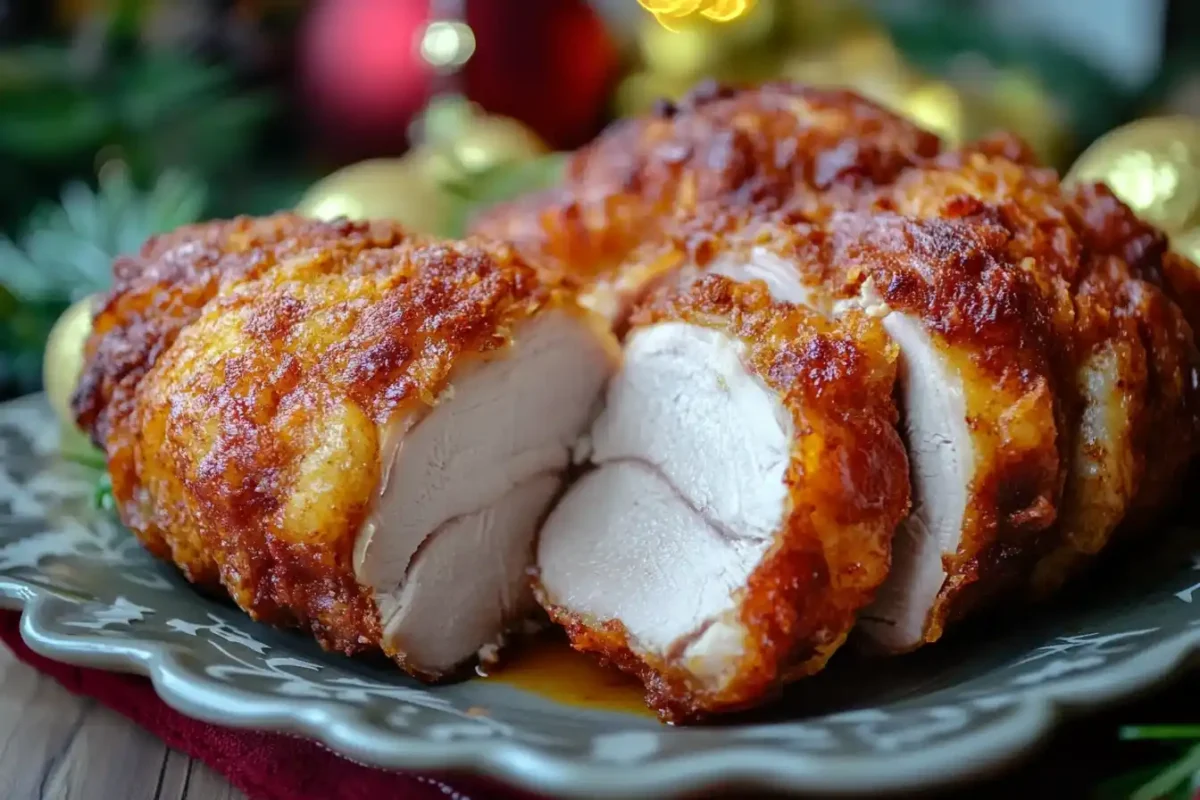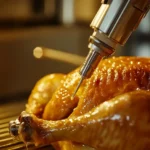Why Injecting a Turkey Before Frying Matters
There’s nothing quite like a deep-fried turkey crispy on the outside, juicy and flavorful on the inside. But if you’ve ever had dry or bland turkey, you know how disappointing it can be. The secret to the perfect fried turkey? Injecting turkey before frying.
Using an injection marinade allows you to infuse rich, bold flavors directly into the meat, ensuring that every bite is juicy and delicious. Unlike traditional brining, which takes hours and requires large containers, injecting turkey before frying is quick, efficient, and incredibly effective. Whether you love a classic buttery garlic injection or a spicy Cajun kick, injecting guarantees maximum flavor in minimum time.
In this guide, you’ll learn exactly when to inject turkey before frying, the best marinades to use, and common mistakes to avoid. By the time you finish reading, you’ll have all the tools and techniques needed to create the most mouthwatering deep-fried turkey ever!
When Should You Inject a Turkey Before Frying?
Timing is everything when it comes to injecting turkey before frying. Inject too early, and the flavors might not be as strong. Inject too late, and the marinade won’t have time to properly absorb into the meat.
How Long Before Cooking Should You Inject a Turkey?
For the best results, inject your turkey at least 12-24 hours before frying. This allows the marinade to fully penetrate the meat, enhancing both flavor and juiciness. The longer you let it sit, the better the results.
Can You Inject a Turkey Too Early?
Yes, but only if you use a marinade with high acidity. Citrus-based injections can start breaking down the meat if left for more than 24 hours. If using butter-based or broth-based injections, you can safely inject up to 36 hours in advance.
Should You Inject a Turkey Right Before Frying?
While you can inject your turkey right before frying, you won’t get the best results. The marinade needs time to distribute throughout the meat. If you’re short on time, inject at least 2-4 hours before frying to allow some absorption.
What Happens If You Don’t Let the Injection Absorb?
If you fry a turkey immediately after injecting, you might notice uneven flavoring. The outer parts will be flavorful, but the inside may still be bland. Letting the marinade sit ensures deep, even seasoning.
Best Ingredients for a Flavorful Turkey Injection
Not all marinades are created equal! The best injecting turkey before frying recipes include a mix of fat, liquid, and seasonings to maximize moisture and taste.
Butter-Based Injections for Rich Flavor
Butter is a popular base because it adds richness and helps create a juicy turkey. Try mixing melted butter with garlic, herbs, and a splash of broth for a classic, savory injection.
Spicy Cajun Injections for a Kick of Heat
If you love bold flavors, a Cajun injection is perfect. Ingredients like hot sauce, paprika, cayenne, and Worcestershire sauce create a spicy, smoky turkey that’s packed with flavor.
Herb & Garlic Injections for a Classic Taste
For a traditional flavor, combine fresh herbs like rosemary and thyme with garlic, broth, and butter. This combination works well for those who enjoy a more subtle, aromatic taste.
Sweet & Savory Injections for Balanced Flavor
Want a little sweetness? Try a mix of maple syrup, honey, or brown sugar combined with soy sauce and black pepper. This balances savory and sweet for a unique twist.
Step-by-Step Guide: How to Inject a Turkey for Deep-Frying

Now that you know the best ingredients and timing for injecting turkey before frying, let’s walk through the process step by step.
Choosing the Right Meat Injector
A high-quality meat injector makes all the difference. Look for a stainless steel injector with multiple needle sizes to handle different marinades. A wide needle works best for thicker butter-based injections, while a narrow needle is great for thin, broth-based marinades.
Where to Inject Turkey for Even Flavor Distribution
To ensure even flavor, inject your marinade into multiple locations. Focus on the thickest parts of the turkey:
| Injection Area | Reason |
|---|---|
| Breasts | The thickest part, often the driest—needs extra moisture |
| Thighs | Dark meat absorbs flavors well and stays juicy |
| Drumsticks | Provides a balance of tenderness and seasoning |
| Wings | Optional but adds extra flavor |
How Much Injection Marinade Should You Use?
A good rule of thumb is to use about 1 ounce of marinade per pound of turkey. Over-injecting can cause the meat to become mushy, while too little won’t provide enough flavor.
How to Prevent Leaking and Uneven Flavor
- Inject slowly while pulling the needle out slightly to distribute the marinade.
- Massage the turkey after injecting to help spread the marinade evenly.
- Let the turkey rest in the fridge for at least 12 hours to prevent leaks.
Common Problems & Solutions When Injecting a Fried Turkey
Even if you follow the right steps for injecting turkey before frying, things can sometimes go wrong. Maybe your marinade leaked out, or your turkey didn’t turn out as flavorful as expected. Don’t worry! Here are the most common problems and how to fix them.
Why Did My Turkey Injection Leak Out?
One of the biggest issues people face when injecting turkey before frying is losing all that flavorful marinade as soon as they inject it. If your injection leaks out, your turkey won’t absorb as much flavor.
✔ Why It Happens:
- Injecting too close to the surface
- Pushing too much liquid into one spot
- Not letting the turkey rest long enough
✔ How to Fix It:
- Inject deep into the thickest parts of the turkey (breasts, thighs, and drumsticks).
- Slowly inject while pulling the needle out slightly to spread the marinade.
- Let the turkey rest for at least 12 hours in the fridge to allow absorption.
How to Avoid Dry or Bland Turkey Meat
A common mistake when injecting turkey before frying is not using enough marinade or choosing a marinade that lacks strong flavors.
✔ Why It Happens:
- Not enough marinade used (less than 1 oz per pound)
- Using only broth without seasonings
- Not letting the turkey rest long enough for the flavors to absorb
✔ How to Fix It:
- Use at least 1 ounce of injection marinade per pound of turkey.
- Use a flavorful mix of butter, garlic, Cajun spices, or herbs.
- Let the turkey rest overnight for deeper flavor absorption.
Can You Over-Inject a Turkey?
Yes! While injecting adds moisture, too much liquid can make the meat mushy and cause uneven cooking.
✔ How to Avoid Over-Injecting:
- Stick to about 1 ounce of injection marinade per pound of turkey.
- Distribute the injections evenly across different areas.
- If the turkey looks swollen or bloated, you may have injected too much.
Does Injecting Affect Frying Time?
Since injecting adds extra moisture, it can slightly increase frying time. However, this difference is usually minimal.
✔ What to Expect:
- A well-injected turkey may take about 3-5 minutes longer per pound due to the added liquid.
- Use a meat thermometer to check for doneness instead of relying on time alone.
- Cook until the internal temperature reaches 165°F (75°C) in the breast and 175°F (80°C) in the thighs.
Best Injection Recipes for Deep-Fried Turkey
Choosing the right marinade is crucial when injecting turkey before frying. Here are four of the best injection recipes to try.

Classic Garlic Butter Turkey Injection
This buttery, garlic-infused injection adds a rich and savory taste to your fried turkey.
| Ingredient | Quantity |
|---|---|
| Unsalted butter (melted) | 1 cup |
| Chicken broth | 1/2 cup |
| Garlic powder | 1 teaspoon |
| Onion powder | 1 teaspoon |
| Salt | 1 teaspoon |
| Black pepper | 1/2 teaspoon |
Best Cooking Method:
- Deep-Frying: Fry at 350°F (175°C) for about 3-4 minutes per pound.
Spicy Cajun Turkey Injection
Perfect for those who love bold, spicy flavors.
| Ingredient | Quantity |
|---|---|
| Butter (melted) | 1 cup |
| Chicken broth | 1/2 cup |
| Hot sauce | 2 tablespoons |
| Cajun seasoning | 1 tablespoon |
| Worcestershire sauce | 1 tablespoon |
Best Cooking Method:
- Deep-Frying: Fry at 350°F (175°C) for about 3-4 minutes per pound.
Lemon Herb Butter Turkey Injection
A fresh, citrusy option with plenty of herbal flavor.
| Ingredient | Quantity |
|---|---|
| Lemon juice | 1/4 cup |
| Chicken broth | 1/2 cup |
| Olive oil | 1/4 cup |
| Fresh thyme (chopped) | 1 teaspoon |
| Fresh rosemary (chopped) | 1 teaspoon |
Best Cooking Method:
- Deep-Frying: Fry at 350°F (175°C) for about 3-4 minutes per pound.
Common Problems & Solutions When Injecting a Fried Turkey
Even if you follow the right steps for injecting turkey before frying, things can sometimes go wrong. Maybe your marinade leaked out, or your turkey didn’t turn out as flavorful as expected. Don’t worry! Here are the most common problems and how to fix them.
Why Did My Turkey Injection Leak Out?
One of the biggest issues people face when injecting turkey before frying is losing all that flavorful marinade as soon as they inject it. If your injection leaks out, your turkey won’t absorb as much flavor.
✔ Why It Happens:
- Injecting too close to the surface
- Pushing too much liquid into one spot
- Not letting the turkey rest long enough
✔ How to Fix It:
- Inject deep into the thickest parts of the turkey (breasts, thighs, and drumsticks).
- Slowly inject while pulling the needle out slightly to spread the marinade.
- Let the turkey rest for at least 12 hours in the fridge to allow absorption.
How to Avoid Dry or Bland Turkey Meat
A common mistake when injecting turkey before frying is not using enough marinade or choosing a marinade that lacks strong flavors.
✔ Why It Happens:
- Not enough marinade used (less than 1 oz per pound)
- Using only broth without seasonings
- Not letting the turkey rest long enough for the flavors to absorb
✔ How to Fix It:
- Use at least 1 ounce of injection marinade per pound of turkey.
- Use a flavorful mix of butter, garlic, Cajun spices, or herbs.
- Let the turkey rest overnight for deeper flavor absorption.
Can You Over-Inject a Turkey?
Yes! While injecting adds moisture, too much liquid can make the meat mushy and cause uneven cooking.
✔ How to Avoid Over-Injecting:
- Stick to about 1 ounce of injection marinade per pound of turkey.
- Distribute the injections evenly across different areas.
- If the turkey looks swollen or bloated, you may have injected too much.
Does Injecting Affect Frying Time?
Since injecting adds extra moisture, it can slightly increase frying time. However, this difference is usually minimal.
✔ What to Expect:
- A well-injected turkey may take about 3-5 minutes longer per pound due to the added liquid.
- Use a meat thermometer to check for doneness instead of relying on time alone.
- Cook until the internal temperature reaches 165°F (75°C) in the breast and 175°F (80°C) in the thighs.
Best Injection Recipes for Deep-Fried Turkey
Choosing the right marinade is crucial when injecting turkey before frying. Here are four of the best injection recipes to try.
Classic Garlic Butter Turkey Injection
This buttery, garlic-infused injection adds a rich and savory taste to your fried turkey.
| Ingredient | Quantity |
|---|---|
| Unsalted butter (melted) | 1 cup |
| Chicken broth | 1/2 cup |
| Garlic powder | 1 teaspoon |
| Onion powder | 1 teaspoon |
| Salt | 1 teaspoon |
| Black pepper | 1/2 teaspoon |
Best Cooking Method:
- Deep-Frying: Fry at 350°F (175°C) for about 3-4 minutes per pound.
Spicy Cajun Turkey Injection
Perfect for those who love bold, spicy flavors.
| Ingredient | Quantity |
|---|---|
| Butter (melted) | 1 cup |
| Chicken broth | 1/2 cup |
| Hot sauce | 2 tablespoons |
| Cajun seasoning | 1 tablespoon |
| Worcestershire sauce | 1 tablespoon |
Best Cooking Method:
- Deep-Frying: Fry at 350°F (175°C) for about 3-4 minutes per pound.
Lemon Herb Butter Turkey Injection
A fresh, citrusy option with plenty of herbal flavor.
| Ingredient | Quantity |
|---|---|
| Lemon juice | 1/4 cup |
| Chicken broth | 1/2 cup |
| Olive oil | 1/4 cup |
| Fresh thyme (chopped) | 1 teaspoon |
| Fresh rosemary (chopped) | 1 teaspoon |
Best Cooking Method:
- Deep-Frying: Fry at 350°F (175°C) for about 3-4 minutes per pound.
Safety Tips for Deep-Frying an Injected Turkey
Frying a turkey is one of the most delicious ways to prepare it, but it also requires extra precautions—especially when using an injecting turkey before frying method. Since injected marinades contain liquid, failing to follow safety steps can lead to dangerous oil splatters or even fires. Here’s how to fry your turkey safely.
Why You Must Let an Injected Turkey Rest Before Frying
If you inject your turkey and immediately drop it into hot oil, the liquid inside can react violently with the oil, causing splattering and potential burns.
✔ How to Prevent Oil Splatter:
- Let the turkey rest in the fridge for at least 12-24 hours after injecting.
- Pat the skin dry with paper towels before frying.
- Ensure your turkey is completely thawed before injecting.
How to Prevent Oil Splattering from Injection Marinade
Oil splatter can be dangerous when deep-frying. The more moisture on your turkey, the higher the risk of hot oil bubbling over.
✔ Key Steps to Stay Safe:
- Completely thaw the turkey before injecting (never inject a frozen turkey).
- Use a lower-oil fill line in your fryer to prevent overflow.
- Slowly lower the turkey into the hot oil to prevent splashing.
Best Temperature and Cooking Time for Fried Turkey
Deep-frying requires precise temperatures to ensure a crispy exterior and fully cooked interior.
| Turkey Weight | Frying Time | Final Internal Temperature |
|---|---|---|
| 10-12 lbs | 30-40 minutes | 165°F (75°C) breast, 175°F (80°C) thigh |
| 12-14 lbs | 40-50 minutes | 165°F (75°C) breast, 175°F (80°C) thigh |
| 14-16 lbs | 50-60 minutes | 165°F (75°C) breast, 175°F (80°C) thigh |
✔ Pro Tips:
- Heat oil to 350°F (175°C) before lowering the turkey in.
- Check internal temperature with a meat thermometer before removing from the oil.
- Let the turkey rest for 20 minutes after frying to allow juices to redistribute.
FAQs About Injecting a Turkey Before Frying
Can I Inject a Frozen Turkey?
No! Injecting a frozen turkey is extremely dangerous because the trapped moisture can expand and cause the hot oil to overflow or explode. Always thaw your turkey completely before injecting.
Should I Inject Turkey Under the Skin or Into the Meat?
For the best flavor, inject directly into the meat. While some people inject under the skin, this doesn’t allow the marinade to penetrate as deeply.
What’s the Best Injector for Thick Marinades?
If using a butter-based marinade, choose a stainless steel injector with a wide needle to prevent clogging.
Can I Use the Same Injection for Other Cooking Methods?
Yes! The same injecting turkey before frying marinades work well for roasting, smoking, or grilling.
Explore More Delicious Recipes
Final Thoughts: Perfecting Your Fried Turkey with the Right Injection Timing
Injecting turkey before frying is the key to a juicy, flavorful bird. Whether you’re using a rich butter-based injection, a spicy Cajun blend, or a citrus-infused marinade, injecting ensures your turkey is packed with moisture and taste.
By following the right timing, using the best ingredients, and taking safety precautions, you’ll create a deep-fried turkey that’s crispy on the outside and tender on the inside.
Have you tried injecting turkey before frying? Share your favorite injection recipes in the comments! And don’t forget to follow us on Facebook for more cooking tips and recipes.
Happy cooking with Rita chef ❤️!
Print
Guide to Injecting Turkey Before Frying
- Total Time: 15 minutes + resting time
- Yield: 1 injected turkey
- Diet: Gluten Free
Description
This turkey injection recipe guarantees the juiciest, most flavorful deep-fried turkey. A perfect blend of butter, broth, and spices ensures a crispy exterior and tender meat with every bite.
Ingredients
Unsalted butter melted 1 cup
Chicken broth 1/2 cup
Garlic powder 1 teaspoon
Onion powder 1 teaspoon
Salt 1 teaspoon
Black pepper 1/2 teaspoon
Paprika 1/2 teaspoon
Worcestershire sauce 1 tablespoon
Lemon juice 1 tablespoon
Fresh thyme chopped 1 teaspoon
Fresh rosemary chopped 1 teaspoon
Instructions
Melt butter and mix with chicken broth in a bowl
Add garlic powder onion powder salt black pepper paprika Worcestershire sauce lemon juice thyme and rosemary then stir well
Fill a meat injector with the mixture ensuring no air bubbles are inside
Insert the injector needle into the thickest parts of the turkey breast thighs and drumsticks then slowly inject while pulling the needle out slightly to distribute the liquid evenly
Repeat the process in multiple locations for even flavor absorption
Let the turkey rest in the refrigerator for 12 to 24 hours before frying
Pat the turkey dry before lowering it into hot oil at 350°F 175°C
Fry for 3 to 4 minutes per pound or until the internal temperature reaches 165°F 75°C in the breast and 175°F 80°C in the thigh
Remove from oil and let the turkey rest for 20 minutes before carving
Notes
Allow the turkey to rest after injecting to prevent oil splattering
Use a stainless steel injector to avoid clogging when using thick marinades
Pair with a dry rub for extra crispy skin
Do not reuse leftover marinade that has touched raw turkey
- Prep Time: 15 minutes
- Cook Time: Varies based on weight
- Category: Main Dish
- Method: Injection
- Cuisine: American
Nutrition
- Serving Size: 1 serving
- Calories: 120
- Sugar: 1g
- Sodium: 450mg
- Fat: 10g
- Saturated Fat: 6g
- Unsaturated Fat: 3g
- Trans Fat: 0g
- Carbohydrates: 2g
- Fiber: 0g
- Protein: 1g
- Cholesterol: 20mg

